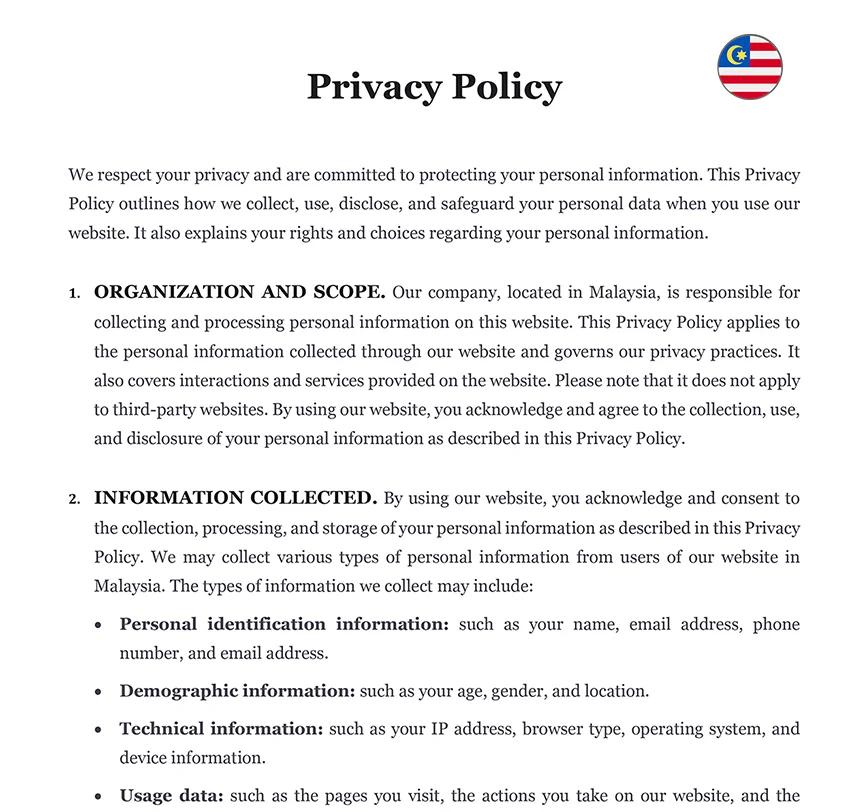Ready to use legal template
Drafted by experienced lawyers
Compliant with Malaysian law
Ready to use legal template
Drafted by lawyers
Compliant with Malaysian law
Home › Intellectual property › Privacy Policy
Learn more about Website Privacy Policy in Malaysia
In Malaysia, privacy policy refers to a legal document that outlines how an organization collects, uses, discloses, and protects personal information of individuals in accordance with the Personal Data Protection Act (PDPA) 2010. The PDPA is the primary legislation governing the handling of personal data in Malaysia. A privacy policy serves as a transparent and informative statement that informs individuals about their rights, the purposes for which their personal data is collected, and how it will be used and protected. Themis Partner offers you an easy to edit Privacy Policy drafted by lawyers to comply with the law in Malaysia.
Table of contents
What is a Privacy Policy?
A privacy policy is a document that outlines how an organization collects, uses, discloses, and protects the personal information of individuals. It serves as a clear and transparent statement that informs individuals about their privacy rights and how their personal data is handled by the organization. It typically includes details on the types of information collected, the purposes for which it is collected, the methods of data collection, and the measures taken to ensure data security. It also specifies how individuals can access, update, or request the deletion of their personal information. Privacy policies are crucial in establishing trust between organizations and individuals, as they demonstrate a commitment to respecting privacy and complying with applicable privacy laws and regulations. By providing clarity and transparency, it helps individuals make informed decisions about sharing their personal information and promotes responsible data handling practices.
Why use a Privacy Policy?
Using it is essential for organizations to establish a clear framework for handling personal information and respecting individual privacy rights. It outlines the Terms and Conditions regarding the collection, use, and disclosure of personal data. By implementing the document, organizations demonstrate their commitment to safeguarding personal information and complying with applicable privacy laws and regulations. This helps build trust with customers, clients, and users by assuring them that their data will be handled responsibly and securely. It provide individuals with important information about the purposes for which their data is collected, how it will be used, who it may be shared with, and the measures taken to protect it. It also informs individuals of their rights regarding their personal data, such as the right to access, correct, or delete their information. By using a privacy policy, organizations not only fulfill legal requirements but also prioritise transparency, trust, and the protection of individual privacy.
What should it include?
1. Types of Information
Clearly specify the types of personal information that may be collected, such as names, contact details, or financial data.
2. Collection and Use
Explain the purposes for which the information is collected and how it will be used, whether for customer service, marketing, or other legitimate business activities.
3. Data Sharing
Indicate whether the information will be shared with third parties and, if so, the reasons and conditions under which this may occur.
4. Data Security
Outline the measures in place to protect personal information from unauthorized access, loss, or misuse, such as encryption or firewalls.
5. User Rights
Inform individuals of their rights regarding their personal data, including the ability to access, correct, or delete their information.
6. Cookie Policy
If applicable, include a separate section explaining the use of cookies on the website or application and how users can manage their preferences.
7. Legal Basis
Specify the legal basis for processing personal information, such as consent, legitimate interest, or compliance with legal obligations.
8. Updates
State how the document may be updated or modified, and how individuals will be notified of any changes.
9. Contact Information
Provide contact details for individuals to reach out with questions, concerns, or requests related to their personal information.
By including these elements, the document can effectively inform individuals about the organization’s data practices, their rights, and the measures taken to protect their personal information.
How does it comply with privacy regulations?
To comply with privacy regulations such as the General Data Protection Regulation (GDPR) or the Personal Data Protection Act (PDPA), privacy policies should incorporate specific requirements outlined in these regulations
| ➤ Firstly, it should clearly state the legal basis for collecting and processing personal data, such as consent or legitimate interest, as required by the GDPR. |
| ➤ It should also provide information about the rights of individuals, including the right to access, rectify, and erase their personal data, as well as the right to object to processing or data portability, as mandated by both the GDPR and PDPA. |
| ➤ Additionally, the document should explain how individuals can exercise their rights and provide contact information for data protection inquiries. |
| ➤ It should outline the security measures implemented to protect personal data, such as encryption or pseudonymization, as required by the GDPR. |
| ➤ Moreover, it should address data transfers to third countries, if applicable, and provide information on cross-border data transfers and safeguards in place to protect the data. |




